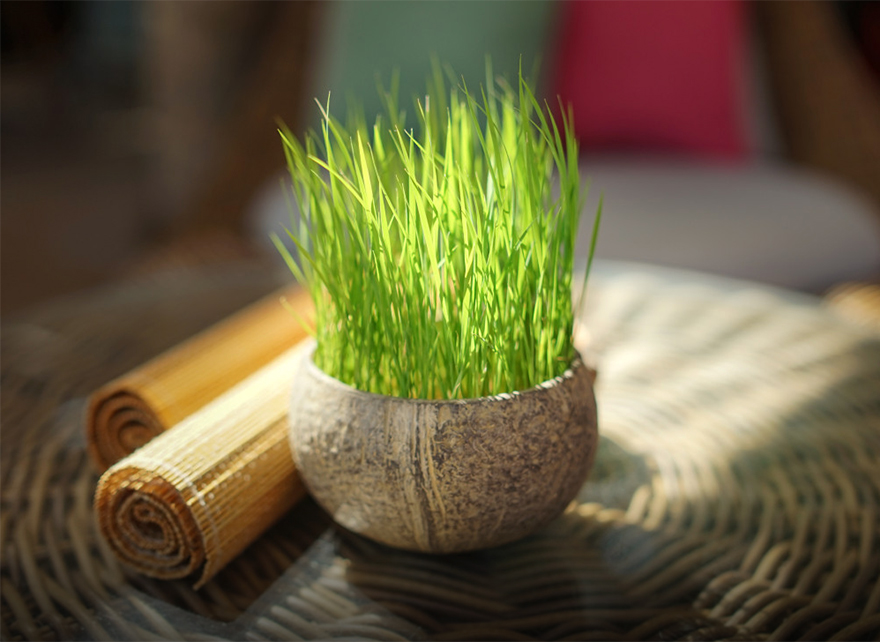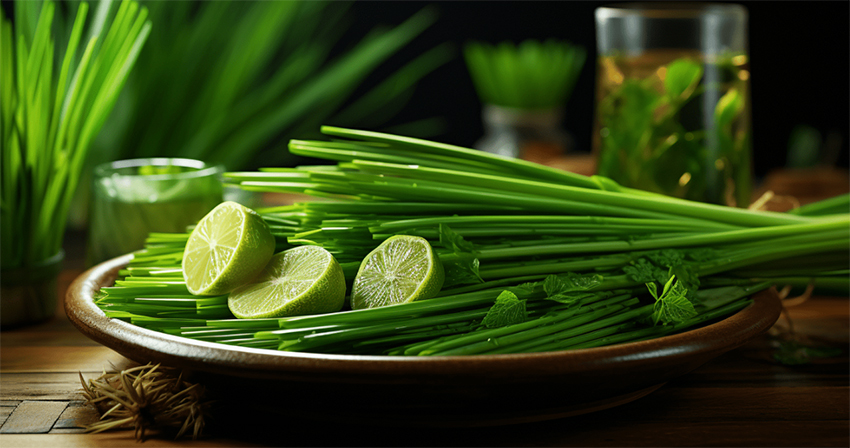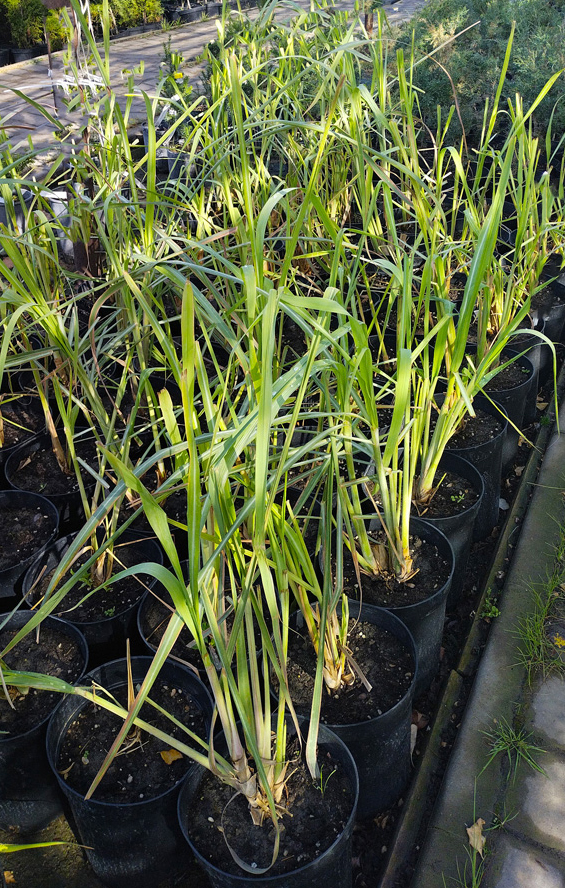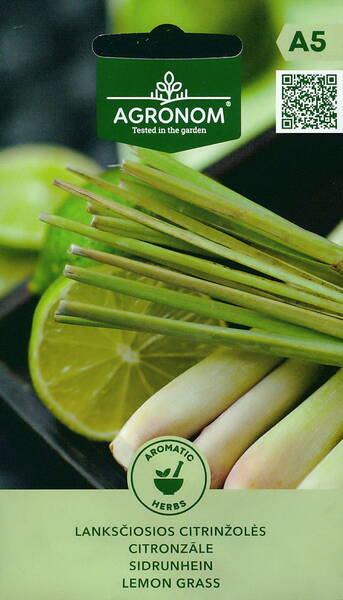Ex Tax: 1.65€
A fast-growing perennial grass up to one and a half meters high with a powerful root system.
10 times stronger than the aroma of lemon! Lemon tea all year round!
Originates from India, Burma and Thailand. Belongs to the genus of evergreen perennials that are found in the wild in subtropical and tropical regions. This plant is widely used for culinary purposes, as well as for the production of cosmetics and as a medicinal plant.
1,0 g contains approximately 2000 seeds.

In Estonia, lemon grass is grown in open ground as an annual crop. And the grass is also attractive because it easily adapts to growing conditions in a pot.
If you decide to plant lemon grass in your garden, then keep in mind some of the features of this plant:
* Lemongrass does not like drafts - their impact can lead to rotting of the root system. Therefore, it is advisable to plant it in places protected from gusts of wind.
* This cereal, like many members of the family, grows quite quickly, which means you need to control its spread and keep it "within the bounds of what is permitted."
* It depletes the soil very quickly.
* The most important thing in caring for lemongrass is regular watering, control of humidity and air temperature.
* The smell of lemon grass is very disliked by mosquitoes and other harmful insects, but it often attracts cats. Therefore, you need to ensure that pets do not get hurt, deciding to treat themselves to the spicy aromatic leaves.

Action: analgesic, antidepressant, antimicrobial, antioxidant, antiseptic, astringent, bactericidal, carminative, deodorant, healing, fungicidal, insecticidal, sedative.
Safety precautions: non-toxic, but may cause skin irritation in some people. Use in moderation.
Aromatherapy: used at home for acne, epidermophytosis, excessive sweating, pediculosis. It tones the skin and tissues well, helps with muscle pain, dyspepsia, colitis, gastroenteritis, and alleviates the course of infectious diseases.
It is used as a fragrance in cosmetics and perfumery. It is widely used in the food industry, as well as in the production of alcoholic and soft drinks. Citral is isolated from it, and it also serves as a substitute for lemon balm and verbena oils. It is best to use fresh stems, but dried ones are also available, as well as powder from dried stems.
If using fresh stems, remove the outer leaves and use only the lower, white part. You can add it to a dish whole (remove before serving), finely chopped or ground into a paste.
Soak dried stems before using. It tastes and smells like lemon zest, has a fresh, clean aroma.
Lemon grass is widely used in Southeast Asian cuisine, especially Thai and Vietnamese. It is added to soups, stews, curries, fish and seafood dishes, chicken, beef and pork. Sometimes it is added to tea. It goes well with garlic, chili pepper and cilantro. If you don’t have lemon grass, you can replace it with lemon zest, verbena or lemon balm.
Growing features.
The plant is quite unpretentious, provide it with sun, warmth +20+25°С, watering, and it will grow perfectly on your windowsill. In open ground, depending on weather conditions, you can also collect a good harvest. This grass can be propagated vegetatively, by dividing the bush or grown from seeds. Seeds are usually sown from February to April in moist soil, sprinkling with a thin layer of earth. Cover the container with a bag - to create humid conditions. Place it in a room with a temperature of +20+25°С. The seeds will germinate in 3-5 days. When the plants grow up, transplant them into separate pots with a diameter of about 8 cm. Plants are planted in open ground when the threat of frost has passed.
Beneficial properties.
Refreshes, eliminates the feeling of fatigue, loss of vitality. Promotes concentration, optimizes mental activity, the ability to remember, increases efficiency, adapts to external conditions. Fills the emotional deficit, which is even manifested in weight loss in phlegmatic, calm, melancholic people.
Eliminates runny nose, sinusitis, maxillary sinusitis, frontal sinusitis. Stimulates the work of blood vessels, motor and respiratory centers.
Eliminates hypotension, dizziness, weakness and darkening in the eyes. Stimulates blood circulation and lymphatic drainage. Increases the efficiency of metabolic processes in the body. Prevents varicose veins. Strengthens ligaments and muscles, increases their endurance (used in sports practice), improves the functioning of the gastrointestinal tract, normalizes the functioning of the stomach with low acidity, stimulates the functioning of the respiratory center, regulates metabolic processes, promotes weight loss, increases lactation, has disinfectant properties.
A decoction of the herb and essential oil is a good remedy for the care of porous oily skin. Helps with acne, inflammation, dermatitis of the skin. Used to combat cellulite.
Even repels mosquitoes...
Lemon grass has a scent that repels insects and is effective in combating mosquitoes: to do this, pluck the stem, rub it vigorously, apply the juice to exposed areas of the skin - you are guaranteed protection from mosquitoes for the next 4 hours.
Harvesting raw materials.
The leaves are cut as needed. Their upper green part is cut into pieces and laid out to dry in the shade. Store in airtight containers and use to make herbal tea (0.5 teaspoon per glass of boiling water). For culinary purposes, use the white fleshy bases of the shoots. They are wrapped in plastic wrap and stored in the refrigerator for several weeks.
Culinary uses.
Lemon grass is one of the herbs that gives Asian cuisine its unforgettable aroma: the smell of citrus with subtle notes of almond. It is added as a spice when preparing soups and when stewing. Lemongrass goes well with cilantro and hot peppers. To use lemongrass in cooking, the leaves are removed, leaving only the lower part of the stem.
Did you know that... essential oil is obtained from lemon grass by steam distillation, which is widely used as a pesticide in candles and lamps to repel insects.
In addition, the oil also protects palm leaves from destruction, which is successfully used in the storage of ancient manuscripts written on palm leaves.

East Indian lemongrass. Bot. syn.: Andropogon flexuosus Nees ex Steudel.
* TOM YAM soup.
Ingredients:
Lemongrass: 3-4 stems.
Frozen shrimp: 250 g.
Fish sauce: 100 ml.
Mushrooms (Oyster mushrooms): 400 g.
Lime: 1 pc.
Chili pepper: 1 pc.
Bow: 1 pc.
Garlic: 3-5 cloves.
Galangal (you can use fresh ginger): 1 pc.
Kaffir lime leaves (can be replaced with lime zest): 1.

How to cook:
Bring 1.5 liters of water to a boil, place the shrimp there for 5 minutes, then remove them, cool and peel them. Remove the veins on the backs. Return the shrimp shells to the broth and cook for 10 minutes.
Beat the lemongrass with a hammer, tear the oyster mushroom caps (without stems) with your hands, cut the fresh ginger (galangal) into thin slices, and remove the seeds from the pepper.
Heat a little vegetable oil in a frying pan, add chopped onion, garlic, chili pepper and fry for 3-4 minutes.
Transfer the mixture to a blender, add a little water and grind to a paste.
Strain the broth, add the resulting paste, lemongrass, lime leaves, ginger (galangal) and cook for 7-10 minutes.
Then add fish sauce and oyster mushrooms. Cook for 5 minutes.
Squeeze lime juice into almost finished soup, add salt and sugar (optional) and shrimp. Warm up for another 2-3 minutes.
Serve the soup hot, generously sprinkled with chopped coriander (cilantro) leaves.












